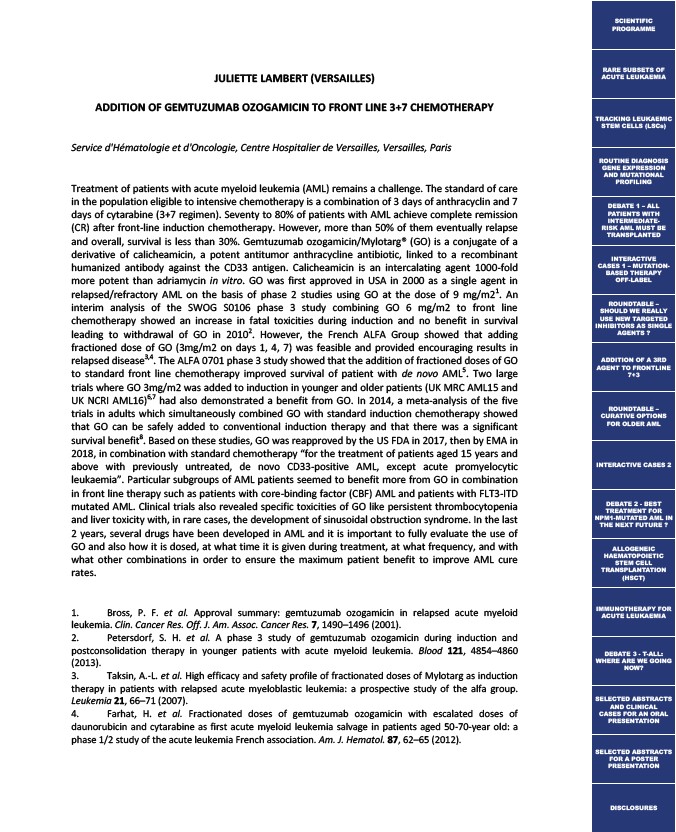
JULIETTE LAMBERT (VERSAILLES)
ADDITION OF GEMTUZUMAB OZOGAMICIN TO FRONT LINE 3+7 CHEMOTHERAPY
Service d'Hématologie et d'Oncologie, Centre Hospitalier de Versailles, Versailles, Paris
Treatment of patients with acute myeloid leukemia (AML) remains a challenge. The standard of care
in the population eligible to intensive chemotherapy is a combination of 3 days of anthracyclin and 7
days of cytarabine (3+7 regimen). Seventy to 80% of patients with AML achieve complete remission
(CR) after front-line induction chemotherapy. However, more than 50% of them eventually relapse
and overall, survival is less than 30%. Gemtuzumab ozogamicin/Mylotarg® (GO) is a conjugate of a
derivative of calicheamicin, a potent antitumor anthracycline antibiotic, linked to a recombinant
humanized antibody against the CD33 antigen. Calicheamicin is an intercalating agent 1000-fold
more potent than adriamycin in vitro. GO was first approved in USA in 2000 as a single agent in
relapsed/refractory AML on the basis of phase 2 studies using GO at the dose of 9 mg/m21. An
interim analysis of the SWOG S0106 phase 3 study combining GO 6 mg/m2 to front line
chemotherapy showed an increase in fatal toxicities during induction and no benefit in survival
leading to withdrawal of GO in 20102. However, the French ALFA Group showed that adding
fractioned dose of GO (3mg/m2 on days 1, 4, 7) was feasible and provided encouraging results in
relapsed disease3,4. The ALFA 0701 phase 3 study showed that the addition of fractioned doses of GO
to standard front line chemotherapy improved survival of patient with de novo AML5. Two large
trials where GO 3mg/m2 was added to induction in younger and older patients (UK MRC AML15 and
UK NCRI AML16)6,7 had also demonstrated a benefit from GO. In 2014, a meta-analysis of the five
trials in adults which simultaneously combined GO with standard induction chemotherapy showed
that GO can be safely added to conventional induction therapy and that there was a significant
survival benefit8. Based on these studies, GO was reapproved by the US FDA in 2017, then by EMA in
2018, in combination with standard chemotherapy “for the treatment of patients aged 15 years and
above with previously untreated, de novo CD33-positive AML, except acute promyelocytic
leukaemia”. Particular subgroups of AML patients seemed to benefit more from GO in combination
in front line therapy such as patients with core-binding factor (CBF) AML and patients with FLT3-ITD
mutated AML. Clinical trials also revealed specific toxicities of GO like persistent thrombocytopenia
and liver toxicity with, in rare cases, the development of sinusoidal obstruction syndrome. In the last
2 years, several drugs have been developed in AML and it is important to fully evaluate the use of
GO and also how it is dosed, at what time it is given during treatment, at what frequency, and with
what other combinations in order to ensure the maximum patient benefit to improve AML cure
rates.
1. Bross, P. F. et al. Approval summary: gemtuzumab ozogamicin in relapsed acute myeloid
leukemia. Clin. Cancer Res. Off. J. Am. Assoc. Cancer Res. 7, 1490–1496 (2001).
2. Petersdorf, S. H. et al. A phase 3 study of gemtuzumab ozogamicin during induction and
postconsolidation therapy in younger patients with acute myeloid leukemia. Blood 121, 4854–4860
(2013).
3. Taksin, A.-L. et al. High efficacy and safety profile of fractionated doses of Mylotarg as induction
therapy in patients with relapsed acute myeloblastic leukemia: a prospective study of the alfa group.
Leukemia 21, 66–71 (2007).
4. Farhat, H. et al. Fractionated doses of gemtuzumab ozogamicin with escalated doses of
daunorubicin and cytarabine as first acute myeloid leukemia salvage in patients aged 50-70-year old: a
phase 1/2 study of the acute leukemia French association. Am. J. Hematol. 87, 62–65 (2012).
SCIENTIFIC
PROGRAMME
RARE SUBSETS OF
ACUTE LEUKAEMIA
TRACKING LEUKAEMIC
STEM CELLS (LSCs)
ROUTINE DIAGNOSIS
GENE EXPRESSION
AND MUTATIONAL
PROFILING
DEBATE 1 – ALL
PATIENTS WITH
INTERMEDIATE-RISK
AML MUST BE
TRANSPLANTED
INTERACTIVE
CASES 1 – MUTATION-BASED
THERAPY
OFF-LABEL
ROUNDTABLE –
SHOULD WE REALLY
USE NEW TARGETED
INHIBITORS AS SINGLE
AGENTS ?
ADDITION OF A 3RD
AGENT TO FRONTLINE
7+3
ROUNDTABLE –
CURATIVE OPTIONS
FOR OLDER AML
INTERACTIVE CASES 2
DEBATE 2 - BEST
TREATMENT FOR
NPM1-MUTATED AML IN
THE NEXT FUTURE ?
ALLOGENEIC
HAEMATOPOIETIC
STEM CELL
TRANSPLANTATION
(HSCT)
IMMUNOTHERAPY FOR
ACUTE LEUKAEMIA
DEBATE 3 - T-ALL:
WHERE ARE WE GOING
NOW?
SELECTED ABSTRACTS
AND CLINICAL
CASES FOR AN ORAL
PRESENTATION
SELECTED ABSTRACTS
FOR A POSTER
PRESENTATION
DISCLOSURES